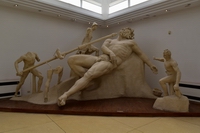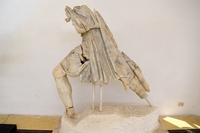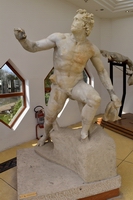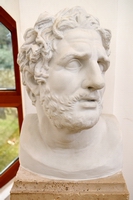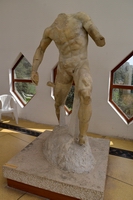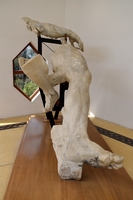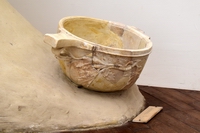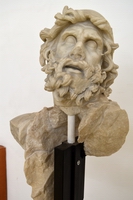Indice dei Musei
presenti in miti3000
Sperlonga Museo Archeologico Nazionale
Testo
Museo Archeologico Nazionale Sperlonga
Sala del Polifemo.
In tale stanza è esposta la ricostruzione del gruppo del Polifemo, realizzata con resine epossidiche, proposta dall’archeologo Baldassare Conticello, insieme ai marmi originali, conservatici relativi a tale gruppo.
Circa il soggetto della composizione si era ritenuto, al momento della scoperta dei marmi (ipotesi di Giulio Jacopi), che esso si riferisse alla vicenda del Laocoonte, sacerdote troiano di Apollo, strangolato ed ucciso assieme ai propri figli dai serpenti inviati da Athena protettrice dei Greci che assediavano la città di Troia.
Tale ipotesi veniva avvalorata dal rinvenimento di una iscrizione marmorea, che è stata successivamente collegata al gruppo di Scilla, recante i nomi degli autori dell’opera: Athanodoros figlio di Agesandros, Agesandros figlio di Peonios, Polydoros figlio di Polydoros, di Rodi. Alla loro officina appartiene anche il Laocoonte rinvenuto a Roma nel XVI secolo nelle Terme di Tito e conservato nelle collezioni dei Musei Vaticani.
È ormai concordemente accettato dagli studiosi che il gruppo raffiguri l’episodio omerico dell’accecamento di Polifemo da parte di Ulisse e dei suoi compagni, prigionieri nell’antro del ciclope.
Tale gruppo, la cui iconografia ci è nota nelle sue grandi linee da una tarda rielaborazione in un rilievo, forse di sarcofago, conservato a Catania nel Museo del Castello Ursino, rappresenta il momento culminante dell’azione da parte di Ulisse e dei suoi compagni per l’accecamento del Ciclope, mentre questi dorme ebbro per il vino bevuto.
Il gruppo è formato dal Ciclope semisdraiato su una pelle di pecora, immerso in un profondo sonno provocatogli dal vino che uno dei compagni dell’eroe gli aveva abbondantemente versato da un otre di pelle che ancora regge con la mano, mentre intorno a lui sono Ulisse e alcuni compagni con il palo appuntito, pronti a conficcarlo nell’unico occhio di Polifemo.
Due dei compagni sono stati quasi integralmente ricostruiti. Uno è a destra, in atto di indietreggiare impaurito alla vista del Ciclope; nella mano sinistra regge un otre di pelle vuoto, il recipiente che conteneva il vino offerto al gigante, la destra è protesa in avanti in un gesto istintivo di terrore. Un secondo compagno sostiene il palo all’estremità, mentre un altro (non ancora completamente ricostruito) lo sostiene nella parte centrale.
Ulisse è in alto sulla roccia a dirigere l’azione dei compagni. Il corpo dell’eroe è ricostruito quasi integralmente; fortunatamente integra ci è giunta la testa con pilos, di altissima potenza espressiva. I più validi confronti per la determinazione della cronologia del complesso possono porsi con i rilievi dell’altare di Pergamo nei Musei Nazionali di Berlino, databili tra il 166 ed il 156 a.C.
Si tratterebbe di un’ottima copia della prima età imperiale da un originale greco della media età ellenistica, ascrivibile alla corrente rodio-pergamena.
The Polyphemus Room.
In this room is exposed the reconstruction of the Polyphemus group achieved with chemical resins, proposed by archeologyst Baldassare Conticello together to the original marbles related to the group.
Concerning the composition of which the subject was related (hypothesis of Prof. Giulio Jacopi) at the time of the discovery of the marbles, that it was referred to the Laocoonte event, Apollo’s Troyan priest, strangled and killed together to his own children, by snackes sent by Athena the Greeks protectress, who had under siege the city of Troy.
Such hypothesis have been revalued from the fìnding of one marble inscription, which later have been linked to the Scylla group, bearing the names of the work authors: Athanodoros son of Agesandros, Agesandros son of Peonios, Polydoros son of Polydoros from Rhodes. To theyr workshop belongs as well the Laocoonte, found in Rome in the XVIth century, in the Titus baths and preserved in the Vatican Museums collection.
It is now agreed and accepted by the expert that, the group represents the Homeric blinding episode of Polyphemus from the part of Ulysses and his companions, who were prisoners in the Cyclope cavern.
Such group, of which the iconography is partially known from the planning of a late relief, perhaps of a sarcophagus, preserved in the museum of the Ursino Castle in Catania, representing the culminating action of Ulysses and his companions, of the blinding of the Cyclope, whilst he was sleeping lied down and drunk from wine.
The group is formed with the Cyclope lied down over a goat skin and fast sleep caused from the wine which one of the hero’s companions, abundantly poured from a goat wineskin which he is still holding with his hand, whilst around him Ulysses and some companions are holding the sharp pole, ready to drive it in the one only Polyphemus eye.
Two of the companions have been almost entirely reconstructed; one is on the right hand side, on the way to draw back scared at the sight of the Cyclope; in his left hand is holding an empty wineskin, the receptacle which held the wine offered to the giant, the right hand is stretched out forward as an instintive terror gesture. A second companion holds the bottom of the pole, another (not yet completely restored) holds the central part of the pole.
Ulysses stands on the upper part of the rock and conducts the companions action. The body of the hero is almost entirely reconstructed; luckily the head is available intact with pilos of a high potential expression. The most valid comparison for the chronology of the complex determination, may be linked with Pergamo’s altar riliefs, in the National Museums of Berlin, dating between the years 166-156 B.C..
It would consists of an excellent copy of the first Imperial age, out from a Greek original of Hellenistic age, related to the rhodio parchment current.
|
Altra foto |
Foto di Giorgio Manusakis per miti3000

